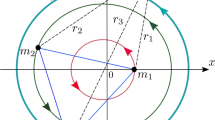Abstract
We consider the problem of the stability of equilibrium points in the restricted equilateral four-body problem where a particle of negligible mass is moving under the Newtonian gravitational attraction of three positive masses (called primaries) which move on circular orbits around their center of masses, such that their configuration is always an equilateral triangle (Lagrangian configuration). We consider the case of two bodies of equal mass, which in adimensional units is the parameter of the problem. We investigate the Birkhoff normal form around the linearly stable equilibrium points L 3 for μ∈(0,0.0027096302) and, L 5 and L 6 for μ∈(0,0.018858526). The quadratic part of the normalized Hamiltonian has no definite sign, so we examine a function which depends on the coefficients of the fourth order normal form and the stability follows from KAM theory if this function is not zero, otherwise the normal form has to be taken to sixth order or higher. This is the case for L 5 and L 6 for one value of μ. We calculate the sixth order normal form and establish the stability of the points in this case of the failure of the fourth order analysis. We also discuss the stability at the 2:1 resonances for the equilibrium point L 3 and the symmetrical L 5 and L 6 points.













Similar content being viewed by others
References
Alvarez-Ramírez, M., Barrabés, E.: Celest. Mech. Dyn. Astron. 121, 191–210 (2015)
Alvarez-Ramírez, M., Vidal, C.: Math. Probl. Eng. (2009). doi:10.1155/2009/181360
Alvarez-Ramírez, M., Formiga, J.K., de Moraes, R.V., Skea, J.E.F., Stuchi, T.J.: Astrophys. Space Sci. 351, 101–112 (2014)
Arnold, V.I.: Sov. Math. Dokl. 2, 247–249 (1964)
Baltagiannis, A.N., Papadakis, K.E.: Int. J. Bifurc. Chaos Appl. Sci. Eng. 21, 2179–2193 (2011)
Budzko, D.A., Prokopenya, A.N.: In: Computer Algebra in Scientific Computing. Lecture Notes in Computer Science, vol. 6885, p. 88 (2011)
Ceccaroni, M., Biggs, J.: Celest. Mech. Dyn. Astron. 112, 191–219 (2012)
Markeev, A.P.: Prikl. Mat. Meh. 35(3), 423–431 (1971)
Meyer, K., Hall, G., Offin, D.: Introduction to Hamiltonian Dynamical Systems and the N-Body Problem. Applied Mathematical Sciences, vol. 90, 2nd edn. Springer, Berlin (2009)
Siegel, C.L., Moser, J.K.: Lectures on Celestial Mechanics. Springer, Berlin (1971)
Simó, C.: Estabilitat de sistemes Hamiltonians. Mem. R. Acad. Cienc. Artes Barc. 48, 303–348 (1989)
Stuchi, T.J.: In: Advances in Space Dynamics, vol. 2, p. 112. CAPES, São José dos Campos (2002)
Author information
Authors and Affiliations
Corresponding author
Rights and permissions
About this article
Cite this article
Alvarez-Ramírez, M., Skea, J.E.F. & Stuchi, T.J. Nonlinear stability analysis in a equilateral restricted four-body problem. Astrophys Space Sci 358, 3 (2015). https://doi.org/10.1007/s10509-015-2333-4
Received:
Accepted:
Published:
DOI: https://doi.org/10.1007/s10509-015-2333-4




